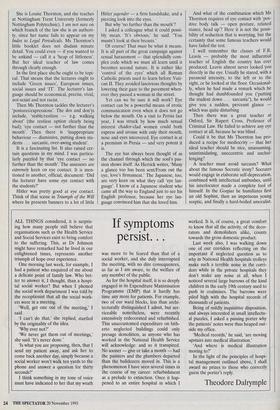If symptoms persist. . .
ALL THINGS considered, it is surpris- ing how many people still believe that organisations such as the Health Service and Social Services exist to bring comfort to the suffering. This, as Dr Johnson might have remarked had he lived in our enlightened times, represents another triumph of hope over experience.
One morning last week, for example, I had a patient who enquired of me about a delicate point of family law. Who bet- ter to answer it, I thought, than a hospi- tal social worker? But when I phoned the social work department I was told by the receptionist that all the social work- ers were in a meeting.
`Well, get one out of the meeting,' I said.
`I can't do that,' she replied, startled by the originality of the idea.
`Why ever not?'
We never get them out of meetings,' she said. 'It's never done.'
`Is what you are proposing, then, that I send my patient away, and ask her to come back another day, simply because a social worker won't walk ten yards to the phone and answer a question for thirty seconds?'
I think something in my tone of voice must have indicated to her that my wrath was more to be feared than that of a social worker, and she duly interrupted the meeting, with no dire consequences, as far as I am aware, to the welfare of any member of the public.
As for the hospital itself, it is so deeply engaged in its Expenditure Maximisation Programme (EMP) that it hardly has time any more for patients. For example, two of our ward blocks, less than archi- tecturally distinguished I admit, but ser- viceable nonetheless, were recently extensively redecorated and refurbished. This unaccustomed expenditure on hith- erto neglected buildings could only presage demolition, as anyone who has worked in the National Health Service will acknowledge: and so it transpired. No sooner — give or take a month — had the painters and the plumbers departed than the bulldozers moved in. This is a phenomenon I have seen several times in the course of my career: refurbishment as a prelude to extinction. Once it hap- pened to an entire hospital in which I worked. It is, of course, a great comfort to know that all the activity, of the deco- rators and demolishers alike, counts towards the gross domestic product.
Last week also, I was walking down one of our corridors reflecting on the important if neglected question as to why in National Health hospitals trolleys make such a terrible noise in the corri- dors while in the private hospitals they don't make any noise at all, when I noticed several large barrows of the kind children in the early 19th century used to push in coalmines. The barrows were piled high with the hospital records of thousands of patients.
Being of mildly inquisitive disposition, and always interested in small intellectu- al puzzles, I asked a passing porter why the patients' notes were thus heaped out- side my office.
`Medical records,' he said, 'are moving upstairs into medical illustration.'
`And where is medical illustration moving to?'
In the light of the principles of hospi- tal management outlined above, I shall award no prizes to those who correctly guess the porter's reply.
Theodore Dalrymple










































































 Previous page
Previous page